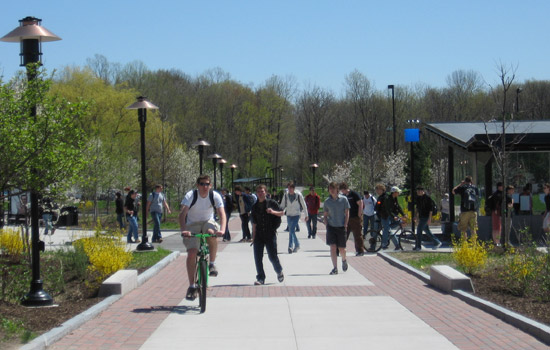RIT wins design award for campus greening project
University recognized for sustainable landscaping
RIT received a design award from the New York Upstate Chapter of the American Society of Landscape Architects for its efforts in enhancing the quality, safety and sustainability of the campus environment.
Rochester Institute of Technology is being recognized for its efforts in enhancing the quality, safety and sustainability of the campus environment.
The RIT Active Transportation Improvements Project has received a 2011 Design Award from the New York Upstate Chapter of the American Society of Landscape Architects.
The project received the Merit Award of Achievement in the category of Built Design.
“RIT has long been a champion of sustainability in the higher education world and it’s gratifying to be recognized for practicing what we preach,” says Enid Cardinal, senior sustainability advisor to the president.
The New York Upstate Chapter of the American Society of Landscape Architects conducts an annual awards competition to recognize outstanding projects of environmental design in our region.
The project, titled Active Transportation, includes walking, bicycling and other modes of human-powered mobility. The 2010 Active Transportation Improvements at RIT support a re-balancing of transportation modes on campus.
Key elements include construction of new multi-use pathways, establishment of bicycle parking facilities and the re-configuration of the Wallace Transportation Plaza to become a multi-modal gateway for the RIT campus. The project makes a significant contribution to the economic and environmental sustainability of RIT.
“We’ve worked with RIT on a number of projects and we always strive to advance the innovation and sustainability objectives of the school,” says Thomas Robinson, senior project manager with edr Companies, the design firm responsible for the project. “We feel as if we hit a home run with this project.”
Each year award entries are judged by a jury of experts from outside New York state. All entries are judged blind, with no reference to the identities of the designers involved. The 2011 Awards Program received 29 professional entries distributed among five categories. A total of nine projects received awards. This year the entries were judged by a multi-disciplinary jury established by the Pennsylvania/Delaware Chapter of the American Society of Landscape Architects.
Criteria for project judging include functionalism, environmental responsibility, sustainability, as well as relevance to the profession, the public and the environment.
For more information on the awards program, go to New York Upstate Chapter of the American Society of Landscape Architects’ website.














